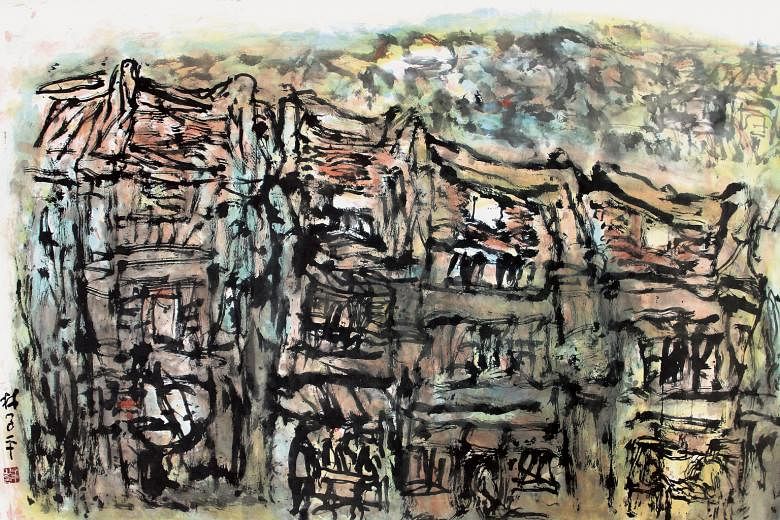It is mid-afternoon in the home studio of Lim Tze Peng, 98, Singapore's oldest living pioneer artist.
For the past few minutes, the prolific painter and his friend, gallerist Terence Teo, have been peering at a painting of a shophouse he has been working on. "I've been wondering whether I should add colour to it or not," Lim tells Mr Teo.
He turns to this reporter in earnest. "What do you think? Give me some feedback. I like it when people critique my work."
Lim may be nearly a hundred years old - he was born in 1921 - but not a day goes by without him practising calligraphy or painting.
The artist, who works on the second floor of his house in Telok Kurau, speaks of his desire to have new breakthroughs and "qiu xin qiu bian" (Chinese for "seek out new things; evolve").
"Painting brings me joy and you could say it's why I've been able to live for so long," says Lim in Mandarin.
"Time is of the essence. I can't spend my time carelessly," he says, adding that he is sometimes too excited about art to sleep. "My family members grumble that I'm always thinking of art, that I don't eat my meals on time, that I sometimes wake up at night and practise calligraphy or think about painting."
He is still reaching new milestones.
He had his first solo show in India several months ago and another exhibition of his works, Lim Tze Peng - National Icon. Centenarian, will run at Ion Orchard from tomorrow to Nov 17.
-
VIEW IT / LIM TZE PENG - NATIONAL ICON. CENTENARIAN
-
WHERE: Ion Art Gallery, Level 4 Ion Orchard, 2 Orchard Turn
WHEN: Tomorrow to Nov 17, 10am to 10pm daily
ADMISSION: Free
INFO: Call 6733-3822 or e-mail info@capeofgoodhope.com.sg
Presented by Mr Teo's Cape Of Good Hope Art Gallery, it features 60 works from different stages in Lim's career - such as earlier kampung and street scenes, depictions of Bali, oil on canvas, paintings of trees and ink works which exemplify his famous style of hutuzi ("muddled calligraphy"), where the uninhibited power of the stroke is favoured over the legibility of the characters.
The show includes some 15 abstract hutuzi works that were painted this year.
Lim, who was born to farmers in a Pasir Ris kampung, started painting in the 1950s. He pursued his passion full time in 1981, after retiring as principal of Xin Min School. He received the Cultural Medallion in 2003 and the Meritorious Service Medal at the National Day Awards in 2016.
In 2012, his Chinese ink painting, Singapore River Scene, went under the hammer for HK$620,000 at Christie's Hong Kong, the first time a work by a living Singapore artist had fetched more than $100,000 at an international auction.
The amiable artist has some usual refrains: Develop a good foundation. Do not take shortcuts. Life is short, but art endures.
He adds: "When you paint, you need to be very serious. I often say an artist should have even more sincerity than a religious man."
Six works to catch
BOAT QUAY (1998)
Lim's oil paintings bear the influence of xieyi, the freely expressive style of Chinese ink painting.
While he experimented with oil previously, he later gave it up in favour of Chinese ink.
"In terms of colour, the Chinese aren't as good as the Europeans or Americans," says Lim, who admires painters such as Huang Binhong and Wu Changshuo.
"When it comes to linework, we definitely beat them. We should hold onto our unique strengths."
CALLIGRAPHY (2014)
This ink on rice paper work is another example of Lim's hutuzi style.
The words - written from memory - are from Tang poet Xu Hun's Early Autumn, a meditative musing on the chilly west wind, the tall trees in the morning and a single, falling leaf.
Painter and art collector Woo Fook Wah observes: "We see how he uses monochromatic Chinese ink to express the dense cluster of trees against the light of dawn in the background."
SINGAPORE RIVER STREET SCENE (2010)
This Chinese ink painting on rice paper captures the strength as well as dilapidation of the buildings on the Singapore River. The work bears the influence of Fauvism (from "wild beasts" in French), which emphasised painterly qualities over the realistic values in Impressionism.
CALLIGRAPHY (2019)
The viewer can barely make out the Chinese words, "ren sheng ru meng" ("life is like a dream"), in this abstract ink painting, part of Lim's increasingly abstract hutuzi ("muddled calligraphy") style.
"I don't want to let people see what the words are. I want them to pay attention to the strokes, to the beauty of the work," he says.
VIGOUR (2003)
Lim has long admired the formal beauty of old trees and their gnarled, twisted shapes.
This ink on rice paper work comes from his Inroads series and offers plenty of scope for him to express his linework.
"I love old trees," he says.
"When I went to Bali with (pioneer artist) Cheong Soo Pieng, I would stop whenever we saw a tree and start drawing.
"Soo Pieng told my friends, 'If you go on trips with Tze Peng, don't take him anywhere with trees.'"
MALAY VILLAGE (1980)
Lim used to paint on site in his younger days, capturing scenes of old kampungs, shophouses and the Singapore River.
This particular ink on rice paper work shows a Malay village in Singapore at a time when the country was developing rapidly.
He says: "I believe these works I've left behind have some historical value. When you look at them, it's quite nostalgic."








